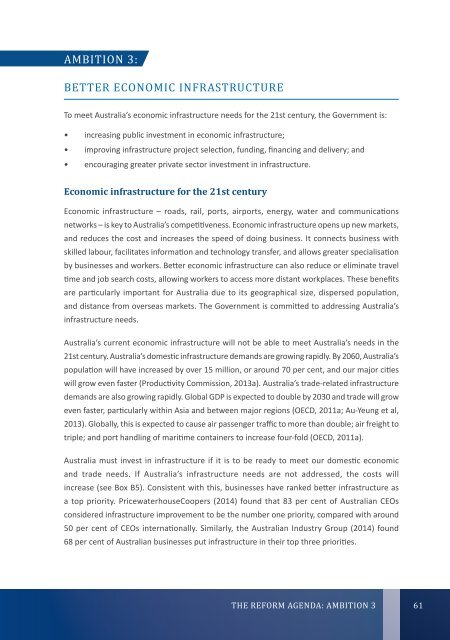Industry-Innovation-and-Competitiveness-Agenda
Industry-Innovation-and-Competitiveness-Agenda
Industry-Innovation-and-Competitiveness-Agenda
Create successful ePaper yourself
Turn your PDF publications into a flip-book with our unique Google optimized e-Paper software.
Ambition 3:<br />
BETTER ECONOMIC INFRASTRUCTURE<br />
To meet Australia’s economic infrastructure needs for the 21st century, the Government is:<br />
• increasing public investment in economic infrastructure;<br />
• improving infrastructure project selection, funding, financing <strong>and</strong> delivery; <strong>and</strong><br />
• encouraging greater private sector investment in infrastructure.<br />
Economic infrastructure for the 21st century<br />
Economic infrastructure – roads, rail, ports, airports, energy, water <strong>and</strong> communications<br />
networks – is key to Australia’s competitiveness. Economic infrastructure opens up new markets,<br />
<strong>and</strong> reduces the cost <strong>and</strong> increases the speed of doing business. It connects business with<br />
skilled labour, facilitates information <strong>and</strong> technology transfer, <strong>and</strong> allows greater specialisation<br />
by businesses <strong>and</strong> workers. Better economic infrastructure can also reduce or eliminate travel<br />
time <strong>and</strong> job search costs, allowing workers to access more distant workplaces. These benefits<br />
are particularly important for Australia due to its geographical size, dispersed population,<br />
<strong>and</strong> distance from overseas markets. The Government is committed to addressing Australia’s<br />
infrastructure needs.<br />
Australia’s current economic infrastructure will not be able to meet Australia’s needs in the<br />
21st century. Australia’s domestic infrastructure dem<strong>and</strong>s are growing rapidly. By 2060, Australia’s<br />
population will have increased by over 15 million, or around 70 per cent, <strong>and</strong> our major cities<br />
will grow even faster (Productivity Commission, 2013a). Australia’s trade-related infrastructure<br />
dem<strong>and</strong>s are also growing rapidly. Global GDP is expected to double by 2030 <strong>and</strong> trade will grow<br />
even faster, particularly within Asia <strong>and</strong> between major regions (OECD, 2011a; Au-Yeung et al,<br />
2013). Globally, this is expected to cause air passenger traffic to more than double; air freight to<br />
triple; <strong>and</strong> port h<strong>and</strong>ling of maritime containers to increase four-fold (OECD, 2011a).<br />
Australia must invest in infrastructure if it is to be ready to meet our domestic economic<br />
<strong>and</strong> trade needs. If Australia’s infrastructure needs are not addressed, the costs will<br />
increase (see Box B5). Consistent with this, businesses have ranked better infrastructure as<br />
a top priority. PricewaterhouseCoopers (2014) found that 83 per cent of Australian CEOs<br />
considered infrastructure improvement to be the number one priority, compared with around<br />
50 per cent of CEOs internationally. Similarly, the Australian <strong>Industry</strong> Group (2014) found<br />
68 per cent of Australian businesses put infrastructure in their top three priorities.<br />
<strong>Industry</strong> <strong>Innovation</strong> <strong>and</strong> <strong>Competitiveness</strong> <strong>Agenda</strong><br />
In<br />
Co<br />
TPO00007<br />
The Reform <strong>Agenda</strong>: Ambition 3<br />
61


